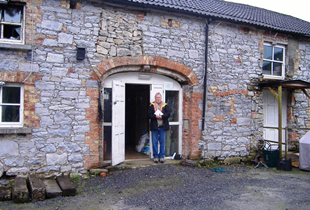History of the McGrath Clan in Ireland
It is known that the various McGrath Clans of Ireland originated at Isle Mcgrath in Co Clare where they have been traced from the 11th Century. They also shared the history of the site from the late Bronze Age when settlers from Scandinavia colonized the area along the Fergus Estuary adjacent to Clare Abbey outside Ennis.
The McGrath family name is derived from the name Macraith which is borne by the descendants of four distinguished septs who had their common origin in the Kingdom of Thomond in present day County Clare. There are at least seven McGrath septs in Ireland today but only four of them originate from Clare. The McGraths of Pettigo, Co. Donegal, the McGraths of Co. Tipperary and the McCraghs of Co. Waterford are all descended from the Macraiths of Isle McGrath in Thomond (McGraw, 2005). Three of the four septs are in the south of modern Eire whereas Donegal is in the north-west but is not part of Ulster. The other three have adopted the name independently. The term clan means a traditional kinship group sharing a common surname and heritage and existing in a lineage based society prior to the 17th Century (McCraw, 2005)
The McGrath family name is derived from the name Macraith which is borne by the descendants of four distinguished septs who had their common origin in the Kingdom of Thomond in present day County Clare. There are at least seven McGrath septs in Ireland today but only four of them originate from Clare. The McGraths of Pettigo, Co. Donegal, the McGraths of Co. Tipperary and the McCraghs of Co. Waterford are all descended from the Macraiths of Isle McGrath in Thomond (McGraw, 2005). Three of the four septs are in the south of modern Eire whereas Donegal is in the north-west but is not part of Ulster. The other three have adopted the name independently. The term clan means a traditional kinship group sharing a common surname and heritage and existing in a lineage based society prior to the 17th Century (McCraw, 2005)
Munster was situated in the south of Ireland. In ancient times, it was one of the fifths ruled by a "king of over-kings." Macraith means "son of Craith" (grace). Macraiths were closely associated with the O‘Brien family, the direct descendants of Brian Boru (941–1014 AD). Indeed it has been suggested that Ahearn, a brother of Brian Boru, is the lineal ancestor of the Mccraiths and hence McGraths. During the reign of Brian Boru the family was eligible for leadership positions in the clan.
The earliest references to the name McGrath occurs in a citation (1086-7) referring to a McGrath who was described as the Chief Poet of the Province of Munster. The McGrath lands were contained within the O’Brien regions around the Killaloe area in Eastern Clare. The O’Briens were the most powerful family in Clare from the 11th to the 16th centuries. After the Normans arrived in the area in 1169 they moved their principal seat from Kincora at Killaloe to Clonroad near Ennis. In the 14th century the Macraiths were running a bardic school there (Wikipedia, accessed February 2013). This area is approximately 25 kilometres south of Kilshanny.
After the Norman invasion (1169), the ancient kingdoms were divided into a number of counties for administrative and judicial purposes. Sovereignty of Thomond was handed over to the Tudors in 1543 and the area joined the Kingdom of Ireland as a county.
The first known McGraths lived at Isle McGrath in the Clare Abbey area near Ennis on the River Fergus, which was built by the O’Briens in 1189. Clan lands were given to them by the O`Brien kings because of their important appointment as Hereditary Poets. It had been a forested area and separate from the mainland in the Ice Age. However, erosion of soil created a delta area which was colonized by Nordic settlers in the Late Bronze Age (500BC). It has recently become an archaeological site and fish traps and jetties are still evident. There are structures which are 115 feet in length and 6 feet wide, interwoven with wattle, which probably functioned as fishing traps and jetties (“The Other Clare”, Shannon Archeological & Historical Society publication (Undated copy in possession of John Collard).
There is evidence that they lived in the area over 1,000 years ago. This is clear from the Charter of Clare Abbey 1189AD, when the area was already named after the family. They were the only Macraith/McGrath family in Ireland at this time.

Isle McGrath 2014
The early Macraiths also had distinguished ecclesiastical careers. It is believed that Brian Boru began a tradition of appointing them to religious offices. McGraths were bishops of at least five abbeys in Clare in the 13th Century and Vatican documents attest to this. In the 14th and 15th centuries they were bishops of Kilfenora, Clare Abbey and Killaloe (Wikipedia, accessed February 2013).
After the English invasion in the 16th Century and the attendant persecution of Catholics and dispossession of church lands in the area some McGraths emigrated to areas such as Waterford and Tipperary. Landlord families such as some of the O’Briens, McMahons and McNamaras became Protestants by 1688 to preserve their privileges (Clare Museum). There are still many McGraths living in Co. Clare, and also in Waterford, Donegal, Tipperary and around the world who all have their roots from this area.